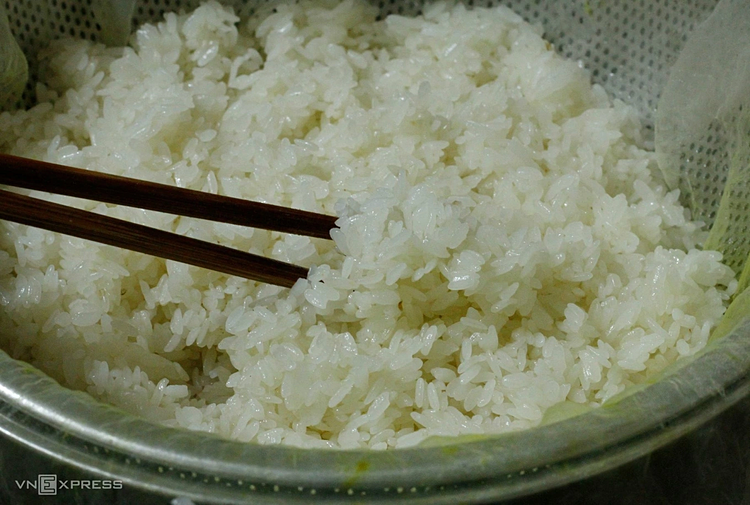Thanh, a Hanoi resident, stands at 1.58 m tall and weighs nearly 60 kg. In an attempt to lose weight, she drastically reduced her carbohydrate and calorie intake. Despite months of effort, her weight plateaued and then increased. She experienced constant stress, insomnia, sugar cravings, and gnawing hunger due to excessive fasting.
During a health checkup, Thanh was diagnosed with class 1 obesity. Her cholesterol levels were alarmingly high at 9.9 mmol/l, double the safe threshold (under 5.1 mmol/l). The doctor explained that elevated bad cholesterol and triglycerides silently accumulate on artery walls, forming plaque that narrows the arteries, obstructs blood flow, and threatens cardiovascular health, increasing the risk of stroke.
Dr. Phan Thai Tan, a weight loss coach, explained that when the body is starved, it switches to a fat-storage mode, leading to weight gain. Consuming few carbohydrates while still indulging in sugar and other refined carbohydrates also increases the risk of high cholesterol and blood sugar. Thanh subsequently received comprehensive dietary and exercise counseling.
Thanh's case is not uncommon. Many people, despite reducing carbohydrates and exercising regularly, still experience weight gain and high cholesterol. On 14/7, Medlatec General Hospital admitted a 22-year-old man suffering from pain and swelling in his left ankle. Tests revealed he had multiple metabolic disorders, including obesity, gout, lipid metabolism disorder, and grade II fatty liver disease.
The young man was surprised by the diagnosis, as he rarely ate carbohydrates and regularly ran and went to the gym. However, he frequently consumed red meat (beef, buffalo), organ meats, seafood, and alcohol, believing exercise would "burn off the calories." The doctor identified these habits as the cause of his high cholesterol and obesity. The patient was advised to drink plenty of water, eat more vegetables and fruits, and engage in regular, light exercise.
 |
A patient experiencing numbness in the limbs and high cholesterol. *Photo: Le Phuong* |
Dr. Tan also noted that many people drastically reduce carbohydrates but remain sedentary. Their bodies don't expend energy as efficiently as those who exercise regularly, which can lead to weight gain.
Furthermore, drastically cutting carbohydrates without balancing other nutrients—for example, consuming excessive fat, sugar, red meat, organ meats, and alcohol while lacking essential nutrients—leads to constant hunger and cravings. These unnecessary substances are converted into stored fat, while the body is deprived of essential nutrients, causing weight gain in the long run.
Many individuals starting calorie restriction initially see results. However, after 6-8 weeks, the body recognizes the reduced calorie intake and adjusts its metabolism, slowing it down and making it harder to burn energy and fat.
Some people severely restrict calories and over-exercise, causing hormonal imbalances. This explains why eating less and exercising more can still result in weight gain. Calorie restriction reduces thyroid hormone activity, slowing metabolism and hindering weight loss. It also increases the risk of deficiencies in essential nutrients for the thyroid, such as zinc, iodine, selenium, and magnesium.
"Therefore, even with carbohydrate restriction, if basal metabolic rate is low, combined with a sedentary lifestyle and low muscle mass, weight loss becomes difficult and can even lead to weight gain and obesity," the doctor explained.
Obesity is a chronic disease similar to diabetes and heart disease, potentially leading to metabolic disorders, high cholesterol, high blood pressure, and chronic inflammation. Excess visceral fat increases bad cholesterol (LDL) and decreases good cholesterol (HDL), leading to atherosclerosis, increasing the risk of stroke and heart attack, according to Dr. Doan Du Manh of the Vietnam Vascular Society.
High cholesterol, whether in overweight or thin individuals, is an abnormal level of lipids in the blood, including increased bad cholesterol (LDL-C), triglycerides, or decreased good cholesterol (HDL-C). According to the World Health Organization (WHO), high cholesterol is linked to 48% of strokes and 56% of myocardial infarctions globally.
In Vietnam, approximately 153,000 people suffer from high cholesterol annually. A survey by the Ho Chi Minh City Nutrition Center of 700 individuals aged 30-69 with normal BMI (18.5-25) found that 77.8% had high cholesterol.
Many obese patients also have high cholesterol. Obesity increases triglyceride, total cholesterol, and LDL levels in the blood while decreasing good cholesterol. Obesity also stimulates insulin resistance, prompting the liver and fat cells to release various fats into the bloodstream, leading to high cholesterol.
High cholesterol often has no specific symptoms, but sometimes shortness of breath, nausea, cold feet, and slow-healing sores can occur. The disease can damage the nervous system, particularly the small nerve fibers responsible for transmitting pain, temperature, and some motor function. When damaged, they can cause numbness, burning, aching, or a pins-and-needles sensation in the extremities.
 |
Excessive carbohydrate restriction can lead to weight gain and increase the risk of high cholesterol. *Illustration: Bui Thuy* |
According to experts, proper weight loss combined with a healthy lifestyle can reduce triglycerides and LDL in the short term and increase HDL levels in the long term. The extent of weight loss and cholesterol reduction varies based on individual factors such as gender, age, lifestyle, diet, exercise, and medical history. Rapid or improper weight loss and cholesterol reduction can have serious side effects, impacting physical and mental health.
Instead of drastically reducing food intake, focus on eating correctly by limiting eating to an 8-12 hour window. Eat slowly, chew thoroughly, prolong meals to over 25 minutes, and include all 4 food groups: carbohydrates, protein, fat, vitamins, and minerals. Aim for 80% fullness.
Use the "plate method" for portion control: 50% vegetables and fruits, 25% protein, and 25% carbohydrates. Choose healthy foods, steaming or boiling vegetables, and making soups. When stir-frying, use healthy oils like olive or avocado oil, and ensure 3-5 colors of vegetables. Prioritize slow-absorbing carbohydrates like brown rice, oats, whole-wheat bread, and sweet potatoes. Include protein from meat, fish, and eggs, limiting red meat to a maximum of 100g/day and no more than twice a week.
Adopt the reverse eating method: consume fiber and vegetable soup first, followed by protein, and finally carbohydrates, to promote early satiety.
Thuy Quynh












